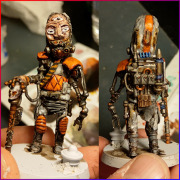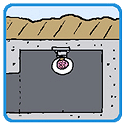|
Volmarias posted:What is the history of war gaming? I'd happily be corrected if I'm wrong, but I was under the impression that most war gaming happened post-Napoleonic era as armies started to be organized and managed in a way we'd consider to be more contemporary. Obviously in the middle ages you'd get nobles spending lots of time and money on training for themselves and their house soldiers, but I think you didn't really see war games and the like until you started getting national armies with general staffs.
|
|
|
|

|
| # ? Jun 10, 2024 22:01 |
|
This is waaaaay the hell out of my field of expertise, but weren't jousting matches a sort of war game/miltiary exercise?
|
|
|
|
Phanatic posted:There's a lot bad poo poo out there.
|
|
|
|
Vincent Van Goatse posted:This is waaaaay the hell out of my field of expertise, but weren't jousting matches a sort of war game/miltiary exercise? Tournaments and jousting weren't military duties that knights had to perform for their lords, they were opportunities to brawl for fun. Like hunting done by the nobility, they were good practice with weapons but were done more for enjoyment's sake. As straight-up jousting became more popular, medieval tournaments concurrently became safer and less like real-life military situations. For example, they switched from real weapons with sharp points to blunt instruments and put a railing in between the participants to prevent head-on collisions. Lots of people still died but by the time one-on-one jousting became a major part of tournaments the heavy cavalry charge, the knight-as-warrior-aristocrat role, and reckless endangerment were all on the decline.
|
|
|
|
SeanBeansShako posted:Gay Black Hitler started the 2nd World War in both China and Europe riding the back of a Polish ammunition carrying bear. 
|
|
|
|
I don't remember when or where, but I read about the history of the bayonet as an instrument of war, and how it was frequently eclipsed by the trusty "hit them with the butt of your gun", especially during the Napoleonic period, since bayonets could get stuck in a body. Is this true, or just a gross exaggeration? I love military history, so I can't believe I just found out about this thread.
|
|
|
|
It got posted earlier probably fifty pages back now but in the pacific theater of the second world war the preferred weapons of US Marines in close quarters melee combat were trench spades, KA-BARs and Colt .45s (shut up, we're talking contact shots). I believe in that order; the colt reigned supreme either way. A bayonet sure could impale a man but it was too slow for repeated strikes plus that whole nasty business of getting wedged into bone meant it wasnt the best bet against some half-starved Japanese soldier grappling with you and scrambling for any advantage or leverage; biting, groin strikes, eye gouging, what have you. The spade had mass and a shovels edge is sharper than you'd think when you're chopping and bludgeoning a human body. The knife is faster and while I'm not an authority on knife fighting, I had a friend and his bud stabbed three times each after getting jumped with both incapacitated instantly and one dead before lifeflight made it and the whole ordeal lasted the whole of five seconds. The pistol would be brutality incarnate. Contact shots are loving grievous. Each trigger pull would cause enormous tissue damage from gaseous discharge alone, let alone a projectile hitting at muzzle velocity, which is the fastest a bullet will ever be after being fired and quitting the barrel. This in no way answers your question so I'm happy to not be of help.
|
|
|
|
Frostwerks posted:It got posted earlier probably fifty pages back now but in the pacific theater of the second world war the preferred weapons of US Marines in close quarters melee combat were trench spades, KA-BARs and Colt .45s (shut up, we're talking contact shots). "In a man to man fight, the winner is he who has one more round in his magazine." - Erwin Rommel Rommel took a bullet to his leg after leading a bayonet charge in WWI. It made him realize that bayonet charges don't belong to the era of firearms. Any firearm is better than a bladed weapon or spade in any theater of combat. How many Americans were killed with a katana in the Pacific theater? (In combat, not in POW camps) The marine with a belly full beans and a loaded M3 submachine gun was much deadlier than japanese soldier with a katana and a belly full of bushido.
|
|
|
|
Could someone give me a quick overview of how the British Army was organized on a sub-battalion level during WWI? How were platoons and squads designated (names, numbers etc), and who led them? Were there even such things as individual squads in any meaningful sense? What was the smallest unit used?
|
|
|
|
Azran posted:I don't remember when or where, but I read about the history of the bayonet as an instrument of war, and how it was frequently eclipsed by the trusty "hit them with the butt of your gun", especially during the Napoleonic period, since bayonets could get stuck in a body. I am also not an expert, but from what I read, I gathered the impression that the bayonet is more for when a guy pops out in front of you and you're holding your rifle. If you stab and miss, you're pretty much screwed, but with a knife you can repeat strikes a lot faster, and in closer quarters. Both knives and sharpened trench shovels were widely used by the Soviets in hand to hand combat, but I haven't read anything to suggest they were favoured over the bayonet.
|
|
|
|
Pyle posted:"In a man to man fight, the winner is he who has one more round in his magazine." I'm not in disagreement? The author of said opinion was a real life honest-to-god primary source. Also gently caress bushido. No such thing as honor when you're killing people. Certainly not in industrial warfare. There's efficacy and economy and those are the only things that count, sad as it may at first seem. And while not a particularly many American or Commonwealth or any flavor of resistance be they uniformed or irregular perished in actual combat by katana or bayonet or whatever antiquated melee murder method you can conceive in the second world war, you can bet that to the few who endured such terrors, they'd have been appreciative of any help at hand be it blade, bludgeon or firearm. But they'd appreciate most of all the most lethal option. (It's the loving firearm!)
|
|
|
|
Frostwerks posted:
[quote="Neal Stephenson" ]"Hey," Shaftoe says, "if we surrender to you, you'll kill us. Right?" "Yes." "If you guys surrender to us, we won't kill you. Promise. Scout's honor." "For us, living or dying is not the important thing," Goto Dengo says. "Hey! Tell me something I didn't loving already know!" Shaftoe says. "Even winning battles isn't important to you. Is it?" Goto Dengo looks the other way, shamefaced. "Haven't you guys figured out yet that banzai charges DON'T loving WORK?" "All of the people who learned that were killed in banzai charges," Goto Dengo says.[/quote]
|
|
|
|
Pretty sure he was asking about Bayonets in the 18th century guys. The spirit of WW2 discussion loves hanging about in this thread. Though it is reasonable, seeing it was one of the biggest events of the last century. Mass bayonet charges in the 18th century were the deal breakers of Napoleonic Battles and skirmishes if it wasn't Cavalry or shot, not damage but morale wise. Soldiers who survived several bloody stressful close range volleys with muskets seeing all the blood and chaos of war about them suddenly change their minds really quickly about the whole 'following' orders thing when the line infront of them is screaming and running at them with pointy sticks. You'd have to have balls and a larger amount of men to try and stand a massed bayonet charge. You couldn't trigger mass routs with the butt of the musket. And in an era where anything but a minor contact wound on the flesh was lethal and could mean bleeding out or amputation being stabbed by a loving bayonet was something no man wanted. Especially when the guy on the other end has no qualms in twisting it to get it out
|
|
|
|
|
Another thing to consider is that bayonets functioned best in dense, organized formation as a cavalry deterrent as a supplement and eventual replacement of pikes. By the time the infantry charge typically came the serious fighting was done or the commander was harebrained. Scatter the remnants and let your cavalry havoc the fleeing and disorganized rest. Or just shoot them in the back. That often worked. I figure the cavalry charge was forever doomed except in the rarest circumstance after the advent of even muzzle loading rifles. efb. Also, I said from the get-go that I was happy to be of no help to that particular question. e2: gently caress it, regarding the horrors of musket volleys, you would actually be seeing your comrades being rent unrecognizable by the enormous bores of small arms alone. I'm just checking the brown bess musket from most the 18th to a significant chunk of the 19th and the round shot was .71 inches. They'd be blown to bits of bone and blood and brain and their body would be vomiting geysers of viscera the likes that would put cormac mccarthy to shame. Nasty, nasty business. Frostwerks fucked around with this message at 15:20 on Sep 27, 2012 |
|
|
|
The bayonet is one of those weapons that's been oddly fetishised far beyond it's actual usefulness. (in terms of killing power) The original poster asked about bayonets during the Napoleonic Period; the answer is that there are multiple commentators from across Europe who all agreed that one could spend a lifetime in military service and see actual bayonet combat only once or twice. What would happen is that one side would start a bayonet charge and then just before contact either the defender or attacker would would lose heart and run away. Either the defender because they saw a mass of pointy sharp steel moving rapidly in their direction without any signs of stopping or the attacker because it became clear that the defender wasn't going to run away (and all other things being equal, a defending formation is for obvious reasons going to be more coherent than a mass charge). In the Napoleonic era soldiers defined their safety as being part of a coherent unit - that's why things like Regimental Colours were so sacred, it wasn't a matter of quaint honour; the ability to identify with a certain position and group of men on the battlefield was literally a matter of life or death. When the odd person started to run here and there then the regiment would start to become a less and less safe place, until a tipping point happened when even the bravest soldiers realised that they couldn't fight with 1/3 of their numbers gone and everyone left would turn and run at the same time. Where bayonet contact did happen it's almost always in broken terrain or cover - behind a stone wall, on city fortifications in a breach, on the edge of woods etc. ie. they're all places where the soldier can identify his safety more strongly in the position he's standing in than with the people he's standing with. A lot of the 'art' of tactics of the period consists of discussion over the precise way and timing of launching and defending against a charge, combined with the problem of firepower in that every volley a regiment fired after the first would get progressively less effective as noise and smoke obstructed accuracy and the ability of officers to direct ordered volleys. Ironically, the earlier the defenders started shooting, the more likely it seemed that the attack would be successfully driven in. Various approaches were taken. One was for the attackers to attempt to provoke a firefight at around 150 yards, and then advance about 20 yards in-between each volley until hopefully close enough and still ordered enough to charge. A defending tactic would be to watch this, then just before it was judged the attackers were preparing to charge, march forward and make a surprise counter-charge. Obviously the success of these tactics relied heavily on the judgement of the officers in command and of the discipline of the troops in question (which was why drill was so important). Early French Napoleonic armies used fairly standard line-of-battle tactics. Later armies that relied on the Levée en masse switched to using Grand Columns that often wouldn't bother to engage in ranged combat, they'd just use weight of numbers to smash through. There wasn't really anything like a formal British doctrine at the time, but the ideal that British officers seemed to aspire to was to withhold fire until just before contact, fire only one or two volleys for maximum effect, and then charge immediately afterwards while it was still possible to control the formation. Alchenar fucked around with this message at 15:36 on Sep 27, 2012 |
|
|
|
Who were the crazy old bastards in the Victorian era who glorified the thing? Always wondered this.
|
|
|
|
|
Assholes. Always the assholes.
|
|
|
|
SeanBeansShako posted:Who were the crazy old bastards in the Victorian era who glorified the thing? It turns out that when you spend 100 years fighting wars mostly against people who don't have access to guns or high quality steel then actually the bayonet is pretty awesome. That, and http://en.wikipedia.org/wiki/Cult_of_the_offensive
|
|
|
|
Frostwerks posted:Also gently caress bushido. No such thing as honor when you're killing people. Certainly not in industrial warfare. There's efficacy and economy and those are the only things that count, sad as it may at first seem. As I recall, Bushido was invented to placate a warrior caste who had nothing to do during an era of peace in Japan. It's plain unsafe to have a bunch of maniacs with swords running around when you have a nation to run, so what else to do but make them go around worrying about their own personal honor and sticking incense in their helmets to keep them busy. Also the rules about them having to commit suicide must've been handy for keeping their numbers down. SlothfulCobra fucked around with this message at 15:43 on Sep 27, 2012 |
|
|
|
Mr. Sunshine posted:Could someone give me a quick overview of how the British Army was organized on a sub-battalion level during WWI? How were platoons and squads designated (names, numbers etc), and who led them? Were there even such things as individual squads in any meaningful sense? What was the smallest unit used? I'm not 100% on the British specifically but the big overarching trend for organization over the course of WWI was increasing levels of granularity and more and more subdivision into smaller fireteams, with somewhat contemporary looking units like sappers and infiltrators becoming prevalent in the ranks of just about every country by the end of the war. There were some pretty good posts on that whole phenomenon earlier in the thread but sadly I couldn't find them. But basically, circa 1914 you had somewhat classic late colonial looking armies squaring off regiment by regiment, but by the end of the war there was far far more emphasis on individual initiative and smaller teams of soldiers who would pick their way across no man's land to take out hardened positions. Someone with actual knowledge of military terminology would probably be able to explain things much better than me- my degree is in intellectual history so I get hopelessly lost trying to figure out the difference between a platoon or a squad or a unit or whatever, especially between different nations.
|
|
|
|
Azran posted:I don't remember when or where, but I read about the history of the bayonet as an instrument of war, and how it was frequently eclipsed by the trusty "hit them with the butt of your gun", especially during the Napoleonic period, since bayonets could get stuck in a body. Early "ring" bayonets (a bayonet which simply slides on to the end of the firearm and is held there by friction) could easily get stuck in a body and even slide off when the attacker attempts to pull it out. This problem was solved by the introduction of socket bayonets, which slid onto the weapon and then clicked into place, just like modern bayonet lightbulbs. Both ring and socket bayonets were not much more than long, sharp blades, becoming thinner at the end. We assume that bayonets are designed to kill very quickly, but in reality they simply put their victims into shock, rendering them useless on the battlefield (the victims, not the bayonets). Many victims of ring and socket bayonets died of their wounds later, not immediately after being bayoneted. A soldier would have no problem attaching a socket bayonet to his musket provided he was standing up; if crouching down in low grass, trying not to be seen, it becomes a lot more difficult. The solution to this was sword bayonets. Sword bayonets were primarily used by early riflemen, who tended to be used as skirmishers. They relied on accuracy far more than their musketeer counterparts, so firing with a bayonet already fixed was counterproductive. As they operated in closer proximity to the enemy their bayonets also had to be attachable quickly and without having to give away their position. The sword bayonet could easily get stuck in a mans flesh when used. However, the solution was simply to give the rifle a sharp twist in whichever direction the soldier felt more comfortable, which would instantly dislodge it from bone, muscle, fat etc. This also meant that when the sword was withdrawn it woud drag out its victims entrails, cause massive internal bleeding and send the body into shock, followed by spasms and seizures. It has been said that if you were bayoneted by a socket bayonet and could be treated with a clean bandage and bottle of whisky within, say, twenty minutes, you stood an excellent chance of surviving the initial wound (although infection is another story). If you are bayoneted by a trained and experienced soldier using a sword bayonet you'd need to hope you were within thirty seconds of a 21st-century operating theatre, and even then I don't really rate your chances. One final issue: using the butt of your gun in close quarter combat may be more effective than using a bayonet, dependent on any number of factors. But what a bayonet won out on over club weapons, knives and even firearms (in the Napoleonic era - this changed in the latter half of the 19th century) was the bayonet charge. A bayonet charge would only be ordered when the units officers were satisfied their flanks were protected, there was no danger of a cavalry counter-attack, artillery fire was minor if non-existant and they had numerical superiority. The psychological effect of a thousand soldiers running towards you with glistening swords fixed and the men themselves screaming for your blood can not be overstated. This psychological effect was far more limited in a close quarters, one-on-one, setting. So, in conclusion, bayonets were more useful than using your musket/rifle as a club in the Napoleonic Wars in the following situations:
|
|
|
|
Azran posted:I don't remember when or where, but I read about the history of the bayonet as an instrument of war, and how it was frequently eclipsed by the trusty "hit them with the butt of your gun", especially during the Napoleonic period, since bayonets could get stuck in a body. This was the case with early bajonetts. The socketed bajonett we know was preceeded by the ring bajonett, which simply used a tight-fitting ring around the barrel, which meant that it could get stuck in a body and trying to pull it out could just slip it off the musket. (Same goes for the even earlier plug bajonett, which had the additional disadvantage of, well, plugging up the barrel.) By Napoleons time, use of the bajonett in close combat was actually somewhat more likely than earlier due to the invention of the socket bajonett and a modernisation in the drills used to teach soldiers how to use it, though they were still rare as posters above have noted.
|
|
|
|
Man at his most base solves all problems with regard to combat by a throwing of helmets.
|
|
|
|
No, you flip out your wallet and start comparing the photos of loved ones. Because deep down, despite all the differences and grievances, we are all brothers.
|
|
|
|
Mr. Sunshine posted:Could someone give me a quick overview of how the British Army was organized on a sub-battalion level during WWI? How were platoons and squads designated (names, numbers etc), and who led them? Were there even such things as individual squads in any meaningful sense? What was the smallest unit used? There are a thousand variations but a typical post-1940 British Army batallion was organised something like this: 1 x Batallion HQ: approx 50 men 1 x HQ Company: approx 250 men, split into: 1 x HQ Platoon 1 x Signals Platoon 1 x AA Platoon 1 x Mortar Platoon 1 x Carrier Platoon 1 x Pioneer Platoon 1 x Administrative Platoon 3 x Rifle Companies: approx 125 men, each split into: 1 x HQ Platoon 3 x Rifle Platoons: approx 35 men, each split into: 1 x HQ Section 3 x Rifle Sections: exactly 10 men, each split into: 1 x Rifle Group: 6 men, commanded by a Corporal 1 x Gun Group: 4 men, commanded by a Lance Corporal So the smallest "squads" were Gun Groups, commanded by a Lance Corporal, with the Rifle Group Commander (the Corporal) also being the Section Commander so having overall command of the Section. The Section Commader would typically be armed with a submachine gun whilst his five men would have rifles; the Gun Group would operate a light machine gun, usually a Bren, so would typically fight as part of a Section rather than alone. Sections and Platoons were named with numbers whilst Companies were named with letters. Batallion were also named with numbers whilst the Regiment would always use its full name. Thus, a soldier helping the Lance Corporal operate the Bren Gun could be part of 2 Section, 2 Platoon, B Company, 6th Scots Guards (with the 6th denoting which batallion he belongs to within the Scots Guards Regiment). Some Regiments within the British Army name their companies after battle honours, famous soldiers within that regiment, etc (including, now I come to think about it, the Scots Guards!). But Rifle Sections and Platoons would always be numbered. The only exception is for the Platoons in HQ Company, which may be "Mortar Platoon" etc, depending on the batallion. The structure of Regiments within the British Army is a whole new effortpost which I'll make a start on just as soon as Oxford University accept me to do a PhD...!
|
|
|
|
SlothfulCobra posted:As I recall, Bushido was invented to placate a warrior caste who had nothing to do during an era of peace in Japan. It's plain unsafe to have a bunch of maniacs with swords running around when you have a nation to run, so what else to do but make them go around worrying about their own personal honor and sticking incense in their helmets to keep them busy. It is interesting how Samurai and Daimyo were dealt with during the Meiji restoration. First, a couple of the Daimyos knew which way the wind was blowing so they gave their land to the Emperor as a patriotic gift. Because of cultural reasons or something along those lines, most of the other Diamyos also had to do this or else they'd look bad. They basically all ended up doing it, and for a while they were appointed as governors of the lands they used to own, but then they were ALL recalled to Tokyo and boom, no more Diamyos. At the same time, a ton of Samurai were put on the government payroll, but they were mostly paid in bonds. For a while, they were able to cash the bonds and everything was just fine, but then their pay was halved, and also the bonds were now worthless. Also, they couldn't carry a sword or kill people. There was a Samurai Rebellion (Satsuma Rebellion) after this, which is kind of what "The Last Samurai" is about. It was a pretty big deal, but it failed. Boom, no more Samurai. In a lot of was not much changed though, the influence of the military over Japan's government really kept going until the Japanese surrender in WWII (for a large portion of that time Imperial Japan was an out and out military dictatorship). It's just that after the Meiji restoration it wasn't a Samurai military calling the shots any more. Japan's history of military running roughshod over civilian governments is partially why Japan is not allowed a military today, I think. After all, Germany is allowed to have an army (obviously it's a different situation entirely). I'm sure I've made some mistakes here and there so if someone who knows more wants to clarify things please go ahead. BoutrosBoutros fucked around with this message at 20:00 on Sep 27, 2012 |
|
|
|
duckmaster posted:There are a thousand variations but a typical post-1940 British Army batallion was organised something like this: He said WWI, not WWII. I know it can be confusing considering that 99% of this thread is WWII but sometimes people have questions about other wars.
|
|
|
|
Mr. Sunshine posted:Could someone give me a quick overview of how the British Army was organized on a sub-battalion level during WWI? How were platoons and squads designated (names, numbers etc), and who led them? Were there even such things as individual squads in any meaningful sense? What was the smallest unit used? I appreciate that duckmaster has given the 1940 organisation, but the WW1 organisation was quite different though as you would expect, it changes drastically between 1914 and 1918. In 1914: Battalion HQ (Lt. Colonel) Transport Section Pioneer Section Stretcher Bearers Signallers A Coy (Major) Company HQ (2 Officers, 2 Sergeants, 15 Men) No.1 Platoon (Lieutenant/2nd Lieutenant) Platoon HQ (4 Men) (Sergeant) No.1 Section (12 Men, SMLE) (Corporal) No.2 Section (12 Men, SMLE) (Corporal) No.3 Section (12 Men, SMLE) (Corporal) No.4 Section (12 Men, SMLE) (Corporal) No.2 Platoon As No.1 No.3 Platoon As No.1 No.4 Platoon As No.1 B Coy Nos. 5-8 Platoons C Coy Nos. 9-12 Platoons D Coy No. 13-16 Platoons Bn Machine Gun Section (2x Vickers HMG) (Sergeant) Now, in 1918: Battalion HQ (Lt. Colonel) A Coy (Major) No.1 Platoon (Lieutenant/2nd Lieutenant) Platoon HQ (4 men, 1 Officer) No.1 Section (9 Men, SMLE, Bombers) (Corporal) No.2 Section (9 Men, SMLE & Rifle Grenades) (Corporal) No.3 Section (9 Men, 2 x Lewis Guns) (Corporal) No.4 Section (9 Men, SMLE, ammo bearers for Lewis Guns) (Corporal) Nos. 2-4 Platoons as above B Coy Nos. 5-8 Platoons as above C Coy Nos. 9-12 Platoons as above D Coy Nos. 13-16 Platoons as above In action, it would likely be supported by elements of the Brigade Trench Mortar Company (8 x 3" mortar) and Divisional Machine Gun Battalion (64 x Vickers HMG) as well as Royal Artillery and Tank units held at Divisional level, not to mention Royal Engineer tunneling and sapper units and ASC transport columns. Notes Guards units use numeric designations for Companies and change the names of some ranks. Some Regiments may use sequential letters for companies in different battalions rather than each having A-D. Each Company has a Captain as 2iC, and the Battalion has a Major as 2iC. The given numbers and ranks of men, particularly for the 1918 organisation are of course the textbook ones and may vary considerably, likewise the amount of Companies/Platoons. In 1914, the emphasis, based largely on the Boer war, was on 'winning the firefight' and then charging home with the bayonet. In the regular units, British marksmanship was the best in Europe at the time and indeed the basic musketry qualification in 1914 was more stringent than the modern APWT. The Company was the smallest unit deemed capable of independent action, and in combat, the Platoons were largely controlled directly. Sections existed on paper, but again werent really used except for administrative purposes. In 1918, the lessons of trench warfare had been learned and the infantry dramatically changed to emphasise combined arms rather than concentrating on rifle fire. The balance of firepower in the Platoon is provided by the Lewis Guns, which acted as the Platoon's base of fire with half the platoon either serving the guns or carrying ammo. The other 2 sections were the assault sections used when clearing enemy positions. The Platoon was used as the main unit of action, being able to advance using what we now call Fire and Movement using organic assets. If you are looking at the more 1918 end of the war, I can't recommend 1918: A Very British Victory by Peter Hart enough. Hope that helps though. Edit: Expanded 1914 organisation. Skillness622 fucked around with this message at 18:23 on Sep 27, 2012 |
|
|
|
Frostwerks posted:It got posted earlier probably fifty pages back now but in the pacific theater of the second world war the preferred weapons of US Marines in close quarters melee combat were trench spades, KA-BARs and Colt .45s (shut up, we're talking contact shots). I believe in that order; the colt reigned supreme either way. A bayonet sure could impale a man but it was too slow for repeated strikes plus that whole nasty business of getting wedged into bone meant it wasnt the best bet against some half-starved Japanese soldier grappling with you and scrambling for any advantage or leverage; biting, groin strikes, eye gouging, what have you. The thing is, if soldiers are sneaking up and infiltrating enemy trenches during the night, KA-BARs and spades would be relatively quiet compared to a Colt. There would be a chance of a group of soldiers working their way up and down the trenches stealthily killing a bunch of people as they go, while a bunch of pistols going off will definitely get noticed, and you'd have the whole trench looking for intruders.
|
|
|
|
tallkidwithglasses posted:He said WWI, not WWII. I know it can be confusing considering that 99% of this thread is WWII but sometimes people have questions about other wars. Goddratit Being beaten to an effortpost is bad enough, being beaten to an effortpost because you read the question wrong is unacceptable. I ought to be shot at dawn 
|
|
|
|
I just fell in love with this thread. Your answers were all interesting and useful, who cares about time period. There is no such thing as knowing too much about history, in my opinion. Thanks!
|
|
|
|
Greeks vs. Persians, ca. 1941 - who'd have won?
|
|
|
|
SlothfulCobra posted:As I recall, Bushido was invented to placate a warrior caste who had nothing to do during an era of peace in Japan. It's plain unsafe to have a bunch of maniacs with swords running around when you have a nation to run, so what else to do but make them go around worrying about their own personal honor and sticking incense in their helmets to keep them busy. Bushido, as a coherent and codified ideology, was actually created in the late 19th century, after the Samurai had been driven from power. What Japanese soldiers in WWII believed to be their duty probably differed greatly from what their ancestors believed.
|
|
|
|
Can someone give me an overview of the history of sea mines and anti-sea mine techniques?Nenonen posted:Greeks vs. Persians, ca. 1941 - who'd have won? It goes to the side that gets Gay Black Hitler on it's side.
|
|
|
|
ArchangeI posted:Bushido, as a coherent and codified ideology, was actually created in the late 19th century, after the Samurai had been driven from power. What Japanese soldiers in WWII believed to be their duty probably differed greatly from what their ancestors believed. The book it's mostly based on (Hagakure, i think), was actually written in either the 16th or 17th century, but it was rediscovered in the 19th century. So in a sense, bushido had existed for longer than that, but it only reached mainstream knowledge in the 19th century.
|
|
|
|
Sorry for another WWII question, but hopefully its something not asked every other page; After the Soviets liberated northern Norway in 44/45, or, there were Allied/Norwegian troops there as well but they came later I think(?). But anyway, so Stalin has his Red Army chilling out in Kirkenes with access to the Atlantic and ice free ports. Why/how did he leave so easily/peacefully? There are some differences with there being a sizable number of Allied troops there, and it being pretty much a frozen wasteland with everything worth anything blown up or burned down. (tough that happened in eastern Europe aswell...) So yeah, whats up with that?
|
|
|
|
I'm going to venture a guess here: Norway was out of Stalins perceived sphere of influence.
|
|
|
|
Boiled Water posted:I'm going to venture a guess here: Norway was out of Stalins perceived sphere of influence. I'm glad to see your time in the reeducation center was worthwhile!
|
|
|
|
KillerKatten posted:After the Soviets liberated northern Norway in 44/45, or, there were Allied/Norwegian troops there as well but they came later I think(?). But anyway, so Stalin has his Red Army chilling out in Kirkenes with access to the Atlantic and ice free ports. I thought they gained access to ice free ports anyway with the acquisition of Kaliningrad.
|
|
|
|

|
| # ? Jun 10, 2024 22:01 |
|
KillerKatten posted:After the Soviets liberated northern Norway in 44/45, or, there were Allied/Norwegian troops there as well but they came later I think(?). But anyway, so Stalin has his Red Army chilling out in Kirkenes with access to the Atlantic and ice free ports. Russia already has Murmansk which is equally kept ice free by the Gulf stream, what would they do with some tiny Norwegian fisher village that isn't even connected to their railroad network? They annexed Finnish Petsamo so there's that, but its worth was mostly as a nickel mine. Plus the Allied powers had a deal going on. Soviets could have backed up the Greek communists if they really wanted to maximize their gains.
|
|
|


























